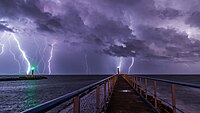
Photo from wikipedia
Besides anthropogenic causes, lightning is the major reason for forest fire ignition worldwide. Information on lightning characteristics and impact points is missing or controversial, due to the difficulty of lightning… Click to show full abstract
Besides anthropogenic causes, lightning is the major reason for forest fire ignition worldwide. Information on lightning characteristics and impact points is missing or controversial, due to the difficulty of lightning stroke localization and the relation to single forest fire events. Austria as an Alpine country experiences a high number of thunderstorms and lightnings, which ignite more than one third of forest fires from June to August. With data from the “Austrian Lightning Detection and Information System” (ALDIS) it was possible to link single lightnings and their characteristics to the location and attributes of individual forest fires. Three subsets with lightning data were compiled and analyzed regarding their strength (kA), polarity (positive or negative) and multiplicity (number of re-strokes). Additional data on the time of ignition, burned area, sea level, exposition and burned vegetation were investigated. Two fire weather sub-indices (FFMC − Fine Fuel Moisture Code and BUI − Build Up Index) of the Canadian FWI (Fire Weather Index) were calculated for the location of the impact point of each lightning and over a period of twenty days, including the day of ignition. Positive lightnings were significantly more likely to induce a fire. Both the FFMC and BUI showed a significant mean decrease after the day of ignition. Precipitation was significant lower at those impact points where forest fires were ignited. Burned area was larger when lightnings ignited during day hours. Most lightning fires occurred at higher altitudes with southerly or western exposition, mainly in stands of Norway spruce (Picea abies L.). Pine species were four times more often affected than the natural tree species distribution would assume. The study results contribute to the international discussion on lightning fires and will help to provide recommendations for further modelling studies on the forecast of lightning caused forest fires.
Journal Title: Agricultural and Forest Meteorology
Year Published: 2017
Link to full text (if available)
Share on Social Media: Sign Up to like & get
recommendations!